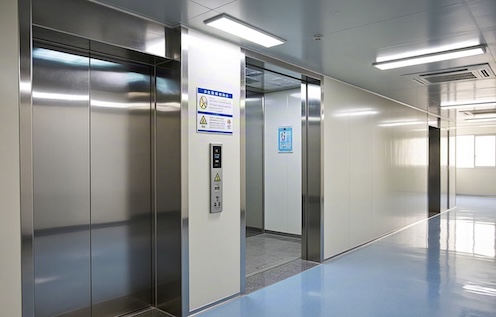In the field of high-end semiconductor manufacturing, a newly-built 12-inch wafer factory is advancing at a rapid pace. The project leader, Johnny, is a seasoned expert in the industry and is well aware that the details of the factory are crucial to the future competitiveness of the global chip market. At this moment, he is worrying about the elevator procurement plan - elevators need to be installed in the clean room to transport wafer boxes, precision equipment and key materials. However, the traditional elevator solutions have fundamental flaws in terms of extreme cleanliness, vibration control and environmental adaptability, which have cast a shadow over the progress of the project.
Johnny once visited a semiconductor factory where a "clean elevator" built using commercial elevators began to experience frequent problems just three months after its commissioning. Once, air seeped through the elevator door gap, causing dust to adhere to the photomask layer and resulting in the scrapping of an entire batch of wafers, causing a loss of several hundred million yuan; another time, the traction machine vibration caused the photomask to have a focus deviation, affecting the precision of the patterns on 1200 wafers, resulting in a loss of over 300 million yuan.
These lessons made Johnny realize that the cleanliness control of traditional elevators was extremely poor. The welding gaps of the commercial elevator car walls were 0.1 - 0.5mm wide, which concealed a large amount of dust and polluted the clean room during operation; the mechanical transmission friction of the door mechanism system produced 0.5 - 10 micron metal particles, polluting the environment; the ventilation system of ordinary elevators had poor filtration and insufficient air exchange, and the particle concentration inside the car could reach five times the standard of a clean room.
Apart from cleanliness, traditional elevators also struggle to meet the high standards of semiconductor production in terms of vibration and environmental adaptability. In advanced manufacturing processes of 7nm and below, production line equipment is extremely sensitive to vibrations. For instance, even the slightest vibration in a lithography machine can cause the lithography pattern to shift; if the vibration of an etching machine is too large, it can damage the surface of the wafer; and if measurement equipment is disturbed by vibrations, the accuracy of the detection will drop significantly.
The asynchronous winding of the traditional elevator traction machine causes vibration with an amplitude of 50 μm, along with 5 - 10 Hz low-frequency vibration; the friction of the guide rail system generates high-frequency vibration; the rigid connection of the car transmits the vibration directly to the load without attenuation. The measured vibration displacement of commercial elevators is 800 times the allowable value for the lithography machine. Even with the installation of vibration isolators, it still cannot meet the requirements of semiconductor manufacturing.
The semiconductor clean room needs to precisely control temperature, humidity, anti-static and deformation, maintain indoor pressure higher than the outside by 5 - 10 Pa to prevent pollution, limit the concentration of volatile organic compounds to ≤50μg/m³to prevent corrosion. However, the ordinary stainless steel of traditional elevators is prone to rust and pollute the air. The poor airtightness at the door gap and other parts causes pressure fluctuations that affect the production line. The high-frequency electromagnetic waves from the motor frequency converter may interfere with measurement equipment, resulting in data errors.

Facing numerous difficulties, Johnny led the team to travel around and communicate deeply with several elevator companies. Eventually, a leading elevator company stood out with three innovative solutions.
Materials:The car body wall uses single-piece 304 stainless steel integrated forming (8mm thick), achieving seamless connection via CNC laser cutting and bending, with electrolytically polished surface to reduce particle adhesion. Welding is replaced by a dual-sealing system (laser and argon arc welding), with gap ≤0.05mm, cutting particulate release from 1200 to 15 per hour.
Drive system: The door mechanism adopts magnetic levitation tech with two permanent magnets, enabling zero-contact operation (0.5mm gap). It opens/closes in 2.5s with noise ≤45dB, no wear after 1 million tests, and reduces particulate release from 800 to 5 per hour while eliminating vibration transmission.
System integration: An EEMS with 200+ sensors monitors real-time parameters and connects to the factory system, adjusting elevator operation dynamically, e.g., switching to "ultra-quiet mode" for photolithography machines or activating VOCs filtration for chemicals, and performing self-cleaning when idle.
Thanks to the efforts of Johnny and the team, the new cleanroom elevator was successfully installed and debugged, providing smooth and precise transportation. This breakthrough in transportation in the microscopic world was achieved, laying the foundation for the production of the 12-inch wafer factory and also providing experience for equipment procurement in the industry.
